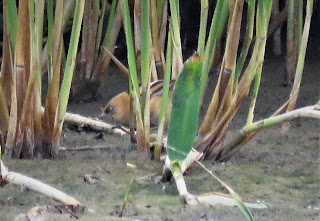 |
| Rain clouds (for a brief moment) at Titchwell! |
A bird from the Americas has once again got my attention as a lesser yellowlegs has been seen at Titchwell all this week. It would be a lifer for me as I have never seen one before. Basically, what I'm hoping to see is the American equivalent of a redshank. However, this 'redshank' has yellow legs and not red ones (though they can appear reddish in some individuals). This one has been showing pretty well in front of the Island Hide throughout this week, so that was where I started my search. Annoyingly though, something (possibly a marsh harrier) has startled everything up into the air from the freshwater pool when I arrived at the hide. The yellowlegs had gone!
 |
| Sea Lavender |
 |
| Black-tailed Godwit |
 |
| Greylags and Avocets |
 |
| Avocets |
 |
| Up they go! |
 |
| Avocet with chick |
I waited in the hide for some time in the hope of it returning to its favourite spot. While I was waiting, a family of bearded tits were hopping around the edge of the reed beds bordering the pool and were providing great views. Away from the reed beds, out in the remaining shallow water were masses of avocets bunched together in a band of black and white. Black-tailed godwits, scruffy-looking ruffs, shelducks, little ringed plovers and lapwings were also about, feeding from the mud exposed by the dry spell we are having. Funny enough, it did actually rain while I was in this hide, but it was a short drizzle, not enough to quench the thirst of the dried up plant life.
 |
| Ruff |
 |
| Lapwing |
 |
| Little Ringed Plover |
 |
| Bearded Tit |
 |
| Lesser Yellowlegs |
Suddenly, an RSPB warden entered the hide and told us that the yellowlegs was now at one of the Parrinder hides on the opposite side of the pool. After a quick confirmation via walkie talkie to his colleague who was at the hide watching the bird in question, everyone (including me) rushed out of Island Hide to go join the crowd there. I entered the hide facing the pool that I had just partly jogged around and there it was. Standing in the smaller pool of water just in front of the hide, busily preening itself alongside a few ruff and black-headed gulls was the bird I had came to see. To be honest, its legs looked more red than yellow and I thought everyone was mistaking it for a redshank. But as everyone was pretty certain that it wasn't a redshank and that there were several experts in the room, I believe them.





So, yes, I have finally seen my first lesser yellowlegs. A new tick to add to my ever growing bird list. I may have confused it with a redshank, but it could be worse, I could have seen it in America where its near identical relatives, the greater yellowlegs, also live sometimes feeding alongside their slightly smaller cousins. I expect some of my American readers of this blog are more accustomed to these two species than I am and can tell the difference pretty easily. But for me, I've never seen either of them until now. It was great seeing this lesser yellowlegs, but am I confident in separating them from other similar looking waders? Probably not. All I need is a greater yellowlegs to make an appearance now to really confuse me.
 |
| Redshank |
 |
| Oystercatchers and Spoonbills |
With my search for the yellowlegs completed, Mum and I made our way down to the beach. Along the way, a flock of distant spoonbills snoozing together on the far side of the tidal pool caught our eye. These large white birds were unmissable. Even with their iconic spoon-shaped bills tucked under their wings, you can easily identify them as there aren't that many white birds that are as big as they are standing upright. On the beach, a seal could be seen poking its head out of the sea, while sandwich terns flew over it. I had a quick search for dune tiger beetles along the sand dunes, but I could only find various species of solitary wasps and bees. We also encountered two small toads during our visit, one while heading out on the reserve and the second as we were returning back.
 |
| Spoonbills |
 |
| Robberfly? |
 |
| One of the Solitary Bees I found on the dunes |
 |
| Toad |













































No comments:
Post a Comment